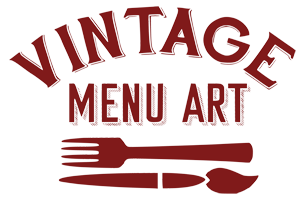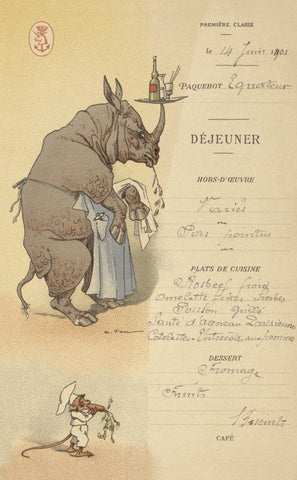Le Paquebot Équateur, 1901 (Rhino)
In 1901, the date of this unusual menu, the white rhino population was near extinction. Perhaps this was why the French liner Équateur chose to display this handsome creature as a waiter - balancing a tray of cocktails on its horn, wearing an apron around its waist, with a corkscrew tucked into the pocket, and chewing a sprig of something green and tasty. A monkey dressed in chef’s whites and chewing a carrot is also in the picture.
The artwork was created by the French illustrator and watercolor artist Auguste Vimar. Born in Marseille, France, in 1851, he became an illustrator for children’s books and contributed some of his wonderful animal images to Le Figaro Illustré (accent on last e). He died in 1916. The rhino and monkey were part of Vimar’s contribution to the fashion at that time for fantastical art images – later this style of artwork became known as magical realism.
Vimar created a range of witty animal-themed illustrations for the Messageries Maritimes fleet - see all the ones we have here.
The Équateur was among the fleet of the Messageries Maritimes, a French merchant shipping company. Its first voyage was in 1876 from Bordeaux in France to Montevideo in Uruguay. In later years it also sailed to Egypt and Syria. It had accommodation for 125 first class passengers, 66 second class passengers, 54 third class passengers and up to 500 immigrants who would have been accommodated in steerage. The ship, which also delivered freight and mail, was taken out of service during the First World War and turned into a floating naval hospital. It was scrapped in 1922.
In the early 1900s, fewer than 200 greater one-horned rhinos existed –thanks to conservation efforts there are now 3,500 in India and Nepal. Fewer than 100 southern white rhinos existed – there are now up to 21,000, living mainly in south Africa. Black rhinos had been almost entirely poached out during the 1970s, but 5,040 and 5,458 black rhinos still exist across Africa, thanks to conversation efforts. The Javan rhino (67 animals remain) and the Sumatran rhino (80 animals remain) are critically endangered, vulnerable to natural disasters and disease.
Courtesy Margaret Barclay Wilson Collection of Books on Foods and Cookery at The New York Academy of Medicine.
All prints come with a white border, for ease of framing.
We make our prints with archival-quality fine art paper, using professional pigment inks. Properly framed or stored, our prints will last 70+ years without fading or discolouring.
All our prints up to A2 size are made in-house in the UK. For larger prints, we work with the best commercial giclée printers in the UK. Learn more about our printing process, borders and custom orders here.

